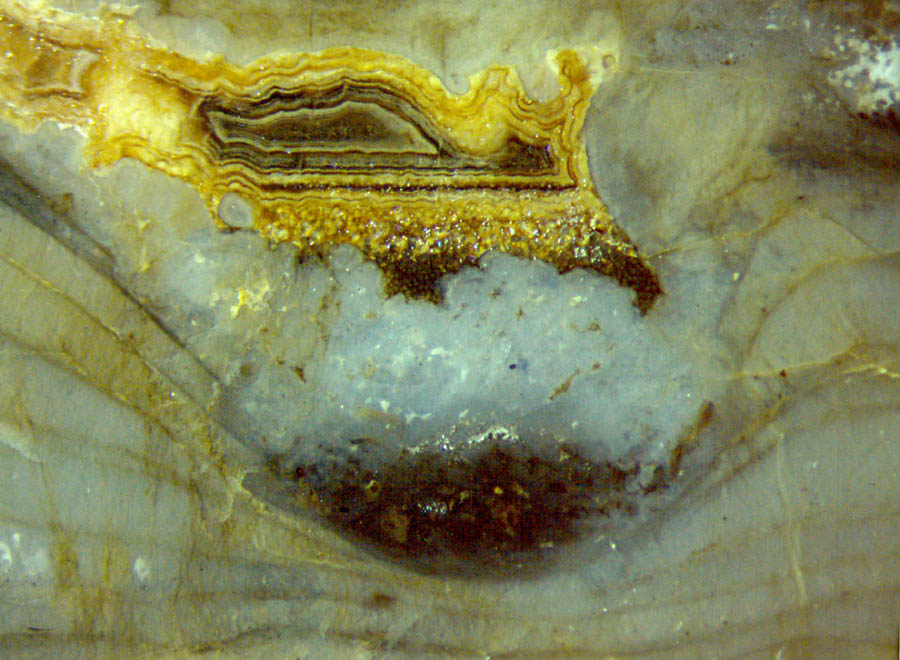Agate and fossil from
watery habitat (3) --- Enigmatic trough
 It is not the conspicuous agate which
is most remarkable here, it is
the "refuse dump" below. It is
a depression in a stack of formerly horizontal layers.
Apparently they consisted
of water with a loose array of microbial
filaments, possibly
of the cyanobacterium Croftalania
[1], very dimly seen here
traversing the layers but
distinctly seen elsewhere in this sample.
The squeezed layers
below the trough
indicate that they had not
yet been silicified then.
It is not the conspicuous agate which
is most remarkable here, it is
the "refuse dump" below. It is
a depression in a stack of formerly horizontal layers.
Apparently they consisted
of water with a loose array of microbial
filaments, possibly
of the cyanobacterium Croftalania
[1], very dimly seen here
traversing the layers but
distinctly seen elsewhere in this sample.
The squeezed layers
below the trough
indicate that they had not
yet been silicified then.
The
aspect of the depression in the layer stack suggests the
idea that it had been
caused by the
heavy debris
now seen at the bottom of the trough. The irregular
particles do not indicate which kind of heavy matter it might be.
Image: Layers of quite different
origin in Rhynie chert:
agate not affected by the large deformation of the microbial
layers below. Width 4.3mm.
Enigmatic
is not only the depressed layer stack but also the disruption of the
upper three layers: They seem to be simply torn off at either side of
the trough, and it is not seen where the parts have gone.
Pale
bluish silica gel shaped like a cumulus cloud or a cauliflower had formed in the water above the debris. The irregular pits at the top of the cloud filled themselves with spherulites, 25-40Ám, with dark liquid in between.
In
a subsequent stage of deposition, yellowish debris of unknown origin
floating in the water
settled into a deposit with rugged horizontal surface and became
silicified.
The
dark horizontal layer above indicates the transient presence of silica
clusters smaller
and larger than a critical size for settling: The larger ones settled
down but the smaller ones were kept in suspension so that they moved
about in the water and eventually got stuck to the cavity wall. Hence,
the dark
horizontal layer continues right and left as a thin
dark layer along the
cavity wall. Subsequent slow diffusion of silica from outside into the
water-filled cavity produced
small clusters only so that the usual process of agate formation
finally filled the cavity with chalcedony.
As it is well known, agate formation is very
sensitive to tiny variations of parameters, which makes every agate a
unique specimen.
Sample:
Rh2/19.2 (2001)
[1] M. Krings, H. Kerp, H. Hass, T.N.
Taylor, N.
Dotzler:
A filamentous
cyanobacterium showing structured colonial growth from the Early
Devonian Rhynie chert.
Rev. Palaeobot. Palyn.
146(2007), 265-276.
H.-J.
Weiss 2019
 |
 |
144 |


 It is not the conspicuous agate which
is most remarkable here, it is
the "refuse dump" below. It is
a depression in a stack of formerly horizontal layers.
Apparently they consisted
of water with a loose array of microbial
filaments, possibly
of the cyanobacterium Croftalania
[1], very dimly seen here
traversing the layers but
distinctly seen elsewhere in this sample.
The squeezed layers
below the trough
indicate that they had not
yet been silicified then.
It is not the conspicuous agate which
is most remarkable here, it is
the "refuse dump" below. It is
a depression in a stack of formerly horizontal layers.
Apparently they consisted
of water with a loose array of microbial
filaments, possibly
of the cyanobacterium Croftalania
[1], very dimly seen here
traversing the layers but
distinctly seen elsewhere in this sample.
The squeezed layers
below the trough
indicate that they had not
yet been silicified then.

